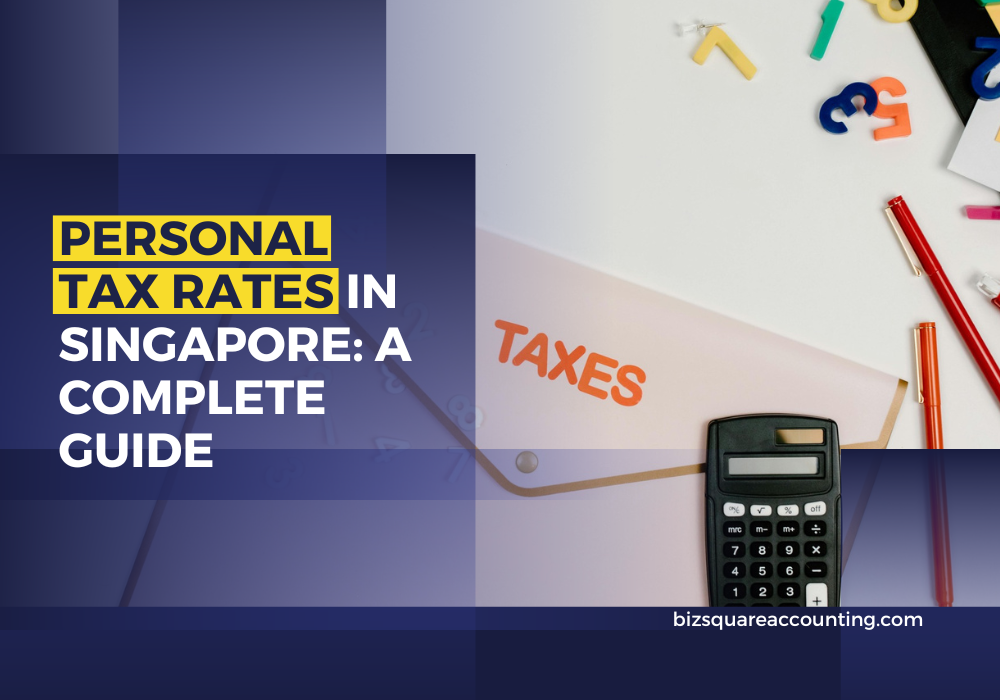Personal tax rates in Singapore play a pivotal role in shaping financial planning across the city-state. In “Personal Tax Rates in Singapore: A Complete Guide,” we break down the tax framework into clear, manageable steps without sacrificing the precision that professionals expect.
In this guide, we explain how the tax system is structured, detail the calculation of tax liabilities, and highlight the practical deductions, rebates, and allowances available. Whether you’re new to Singapore’s tax scene or looking to refine your financial strategies, understanding personal tax rates in Singapore is an essential step toward making informed financial decisions.
An Overview of Singapore’s Tax System
Singapore’s income tax system is widely regarded as one of the most efficient and competitive in the world. In fact, the personal tax rates in Singapore are among the lowest globally, making this small island nation an attractive destination for professionals, entrepreneurs, and investors. The backbone of Singapore’s tax system is a progressive structure that ensures individuals pay tax in accordance with their income levels—low earners benefit from minimal or zero tax, while higher earners pay a larger share.
This progressive model is not only fair but also designed to incentivize savings and investment. When you learn about Singapore’s personal taxes, you’ll quickly notice that the country’s tax system encourages fiscal discipline while still providing generous reliefs and rebates to eligible individuals. In essence, understanding tax rates in Singapore isn’t just a matter of compliance—it’s about unlocking strategies to keep more of your hard-earned money.
Read also: Ensuring IRAS Tax Compliance: The Role of Professional Accounting Services
Determining Your Tax Residency Status

Before we dive into the specifics of how tax is calculated, it’s essential to understand your tax residency status because it determines which tax rates apply to you. Singapore classifies taxpayers into two main groups: residents and non-residents.
Who Is a Tax Resident?
You are considered a tax resident in Singapore if you meet one of the following conditions:
- Singapore Citizens and Permanent Residents: If you live in Singapore for most of the year (allowing for only temporary absences), you automatically qualify as a tax resident.
- Foreigners Who Stay or Work in Singapore: If you have stayed or worked in Singapore for at least 183 days in the preceding calendar year, or continuously for three consecutive years—even if your stay is slightly less than 183 days in the first or third year—you will be treated as a tax resident.
- Foreigners with Continuous Employment: Even if your employment spans two calendar years, as long as your total stay is at least 183 days (including the days immediately before and after your work period), you qualify as a tax resident.
Who Is a Non-Resident?
If you don’t meet the above conditions, you will be classified as a non-resident. Non-residents are taxed only on income earned in Singapore, and different rates and rules apply to them compared to residents.
Understanding whether you fall into the resident or non-resident category is the first step toward grasping Singapore personal taxes. This distinction affects the tax brackets, available deductions, rebates, and even the way your tax return is filed.
How Singapore Personal Taxes Are Calculated
Once you’ve established your tax residency status, the next step is to determine your chargeable income and apply the appropriate personal tax rates in Singapore. The process can seem a bit daunting at first, but it becomes much more manageable once you break it down into clear steps.
Step 1: Determine Your Chargeable Income
Your chargeable income is essentially your total income after deducting allowable expenses, reliefs, and rebates. This figure forms the base upon which your tax is calculated. For example, if you earn income both in Singapore and overseas (if you are a tax resident), you’ll need to include all relevant income, and then subtract any deductions that apply.
Step 2: Identify the Applicable Tax Bracket
Singapore’s tax system is progressive, meaning different portions of your income are taxed at different rates. For instance, the first S$20,000 of income might be tax-free, while income above that threshold is taxed at increasing rates. The tax rates in Singapore are structured to ensure that higher earnings lead to higher taxes—but only on the income that exceeds each threshold.
Step 3: Apply the Relevant Rate
For each segment of your income that falls within a particular bracket, you’ll apply the corresponding tax rate. For example, if you earn S$100,000 in a year, the tax on the first S$20,000 might be 0%, the next S$10,000 at 2%, the following S$10,000 at 3.5%, and so on. Each bracket is calculated separately, and the tax amounts are then summed to give your total liability.
Step 4: Subtract Deductions and Rebates
After calculating the total tax, you need to subtract any deductions or rebates for which you’re eligible. These could include personal reliefs, donations to approved charities, or expenses incurred wholly and exclusively in earning your income. This final step often results in a significantly reduced tax liability, especially for individuals who have maximized their eligible claims.
The calculation process might seem complex, but by following these steps, you can confidently determine how much you owe under Singapore personal taxes. There are also several online tools and calculators available—many on the IRAS website—to help you with these calculations.
Read also: 10 Reasons Why Hiring an Accounting Service in Singapore Saves You More Money
Resident Tax Rates: A Closer Look
For those who are classified as tax residents, Singapore uses a progressive tax system that scales according to your income. Let’s take a detailed look at how these personal tax rates in Singapore are structured for residents.
The Progressive Tax Brackets
Starting from the Year of Assessment (YA) 2024, the tax brackets for residents are as follows:
- First S$20,000: 0% tax.
- Next S$10,000: 2% tax (resulting in S$200 for that bracket).
- Next S$10,000: 3.5% tax (approximately S$350).
- Next S$40,000: 7% tax (about S$2,800).
- Next S$40,000: 11.5% tax (approximately S$4,600).
- Next S$40,000: 15% tax (roughly S$6,000).
- Next S$40,000: 18% tax (around S$7,200).
- Next S$40,000: 19% tax (about S$7,600).
- Next S$40,000: 19.5% tax (approximately S$7,800).
- Next S$40,000: 20% tax (roughly S$8,000).
- Next S$180,000: 22% tax (about S$39,600).
- Next S$500,000: 23% tax (approximately S$115,000).
- Income exceeding S$1,000,000: 24% tax (roughly S$199,150).
These brackets illustrate the progressive nature of tax rates in Singapore. The system ensures that only the income that exceeds each threshold is taxed at the higher rate, not your entire income. This method benefits lower-income earners and makes the overall system more equitable.
Understanding the Changes for YA 2024 Onward
Starting from YA 2024, there have been adjustments aimed at increasing the top marginal rate to enhance progressivity. Now, income between S$500,000 and S$1,000,000 is taxed at 23%, and income above S$1,000,000 is taxed at 24%. These changes are designed to ensure that high-income earners contribute a fairer share while keeping the overall system competitive and attractive.
A Practical Example
Imagine you are a resident earning S$100,000 in chargeable income. Here’s how you might break down your tax calculation:
- First S$20,000: No tax is charged (0%).
- Next S$10,000: 2% tax → S$200.
- Next S$10,000: 3.5% tax → S$350.
- Next S$40,000: 7% tax → S$2,800.
- Remaining S$20,000: 11.5% tax → S$2,300.
By adding these amounts together, you would arrive at a total tax payable of roughly S$5,650. This example clearly demonstrates how personal tax rates in Singapore operate for residents.
Non-Resident Tax Rates Explained
If you are classified as a non-resident in Singapore, your tax situation is handled differently from that of residents. Non-residents are only taxed on income earned within Singapore, and different rates apply.
Flat Rate for Employment Income
For non-resident employees, Singapore generally imposes a flat tax rate on employment income. This flat rate is typically 15%, unless the progressive resident tax rates would result in a higher tax liability—in which case, the higher amount is applied. This ensures that the taxation of non-residents remains fair and is aligned with the overall system of tax rates in Singapore.
Special Considerations for Other Income
For income types such as director’s fees, consultation fees, rental income, and similar earnings, non-residents are subject to a flat tax rate of 24%. This rate is similar to the top marginal rate for residents and reflects the structure of Singapore personal taxes that aims to maintain parity between residents and non-residents.
Withholding Tax on Non-Resident Income
In addition to the above, certain payments to non-resident individuals are subject to withholding tax. For example:
- Directors’ Fees and Consultation Payments: Taxed at 24%.
- Non-Resident Professionals: Depending on whether tax is calculated on gross income or net income, the rates can vary (e.g., 15% of gross income or 24% of net income).
- Public Entertainers and Special Cases: Some professionals may benefit from concessionary rates.
The withholding tax is designed to secure tax collection at the source, reducing the risk of non-compliance. Thus, whether you are a resident or non-resident, understanding Singapore personal taxes is crucial for ensuring that you meet your obligations accurately.
Deductions, Allowances, and Tax Rebates
A significant benefit of Singapore’s tax system is the array of deductions, allowances, and rebates available to help lower your overall tax liability. Let’s explore these in detail.
Common Deductions
Deductions are subtracted from your total income to arrive at your chargeable income. Some of the most common deductions include:
- Employment Expenses: These cover expenses incurred wholly and exclusively in performing your job. Examples include professional membership fees and travel expenses for business purposes.
- Donations: Contributions made to approved charitable or social causes are deductible. This not only reduces your taxable income but also supports community initiatives.
- Business Expenses: For self-employed individuals or business owners, expenses related to running the business—such as office rent, utilities, and salaries—can be deducted.
Taking full advantage of these deductions can significantly reduce the tax burden determined by tax rates in Singapore.
Tax Rebates
Tax rebates work a little differently from deductions; they directly reduce the amount of tax payable rather than lowering your taxable income. For instance, for the Year of Assessment (YA) 2024, many residents are eligible for rebates that can reduce their final tax bill substantially. These rebates might be based on your income level, your family status, or specific policy incentives aimed at providing relief during economic downturns.
Allowances for Families and Dependents
Singapore’s tax system also offers allowances designed to support families:
- Spouse Relief: If your spouse has little or no income, you may qualify for additional relief.
- Parent and Child Reliefs: These allow you to claim deductions if you are supporting parents, disabled parents, or children who meet specific criteria.
- CPF Contributions: Contributions to the Central Provident Fund (CPF) are also eligible for relief, further reducing your taxable income.
All these deductions, rebates, and allowances help lower the effective personal tax rates in Singapore, enabling taxpayers to keep more of their income.
Tax Exemptions
Certain types of income are exempt from taxation in Singapore. For example:
- Overseas Income: Generally, if you are a tax resident, overseas income that is received in Singapore is not taxable unless it is derived from trade or business in Singapore.
- Government Grants, Scholarships, and Awards: These are typically not subject to tax.
- Capital Gains: Singapore does not levy a capital gains tax, so any profit from the sale of investments or property (provided it is not part of a business of trading) is generally tax-free.
Read also: 8 Legal Ways to Reduce Your Personal Income Tax
Filing Your Income Tax Return in Singapore

Filing your income tax return may seem like a daunting task, but Singapore’s system is designed to be as streamlined as possible. Here’s a step-by-step guide to help you navigate the process.
Step 1: Receiving Your Filing Notification
Between February and March, the Inland Revenue Authority of Singapore (IRAS) sends out notifications via SMS, email, or letter. These notifications will inform you that it’s time to file your income tax return. Even if you are under the No-Filing Service (NFS) and have only auto-included income, you should verify the information provided.
Step 2: Determine If You Need to File
Most residents need to file a tax return even if all your income information has been pre-filled by your employer. Use the filing checker tool available on the IRAS website to confirm whether you need to file a return.
Step 3: Choose the Correct Form
Depending on your tax residency status:
- Tax Resident Individuals: You generally need to file Form B1.
- Self-Employed Individuals: File Form B.
- Non-Resident Individuals: File Form M.
Ensure that you have all the necessary documents ready, such as your Form IR8A (if applicable), details of dependents, and any documentation related to other income sources.
Step 4: Declare Your Income
For employees under the Auto-Inclusion Scheme (AIS), your income information will be pre-filled in your tax return. If you are not under AIS or have additional income sources, you will need to manually enter these details.
Step 5: Claim Deductions and Reliefs
Make sure you claim all the deductions, rebates, and personal reliefs for which you are eligible. This could include deductions for employment expenses, donations, rental expenses, and CPF contributions. These claims help reduce your taxable income and lower the effective tax rates in Singapore.
Step 6: Submit and Confirm
After filling in all your details, submit your tax return via the myTax Portal. You’ll receive an acknowledgment once your submission is successful. If you need to make adjustments, you are allowed to re-file within 7 days or before the filing deadline, whichever comes first.
Step 7: Payment of Taxes
Once your tax bill is finalized, payment is due within one month of receiving the bill. Payment options include GIRO, AXS stations, and internet banking. If you are experiencing financial difficulties, you may request a longer payment plan through the myTax Portal.
By following these steps, you can navigate the tax filing process confidently and ensure that you comply with Singapore personal taxes.
Planning and Managing Your Tax Obligations
Good tax planning goes beyond just filing your return—it’s about managing your financial affairs in a way that minimizes your tax liability while keeping you compliant with Singapore personal taxes. Here are some practical tips for effective tax planning:
1. Maintain Organized Records
Keep a detailed record of your income, expenses, and receipts. Organized records make it easier to claim every deduction and relief available to you, reducing your overall tax bill based on the personal tax rates in Singapore.
2. Use Online Tools
The IRAS website offers several online calculators and resources that can help you estimate your tax liability. These tools are particularly useful in planning your finances throughout the year. Regularly checking these tools can keep you informed about any changes in tax rates in Singapore.
3. Stay Informed on Tax Policy Changes
Tax regulations can change from year to year. Keeping yourself updated on the latest developments—whether through the IRAS website, newsletters, or consultations with a tax professional—can help you adjust your financial planning accordingly. This is crucial when understanding evolving Singapore personal taxes.
4. Consult with a Tax Professional
Even if you are confident in managing your own taxes, getting advice from a professional can provide peace of mind. They can help you navigate complex scenarios, particularly if you have multiple income streams or significant changes in your financial situation. Professional advice ensures that you are making the most of the available personal tax rates in Singapore.
5. Plan for Future Changes
Tax planning is an ongoing process. Anticipate upcoming changes, such as the adjustments to tax brackets for YA 2024, and plan your finances accordingly. Whether you are an investor, entrepreneur, or salaried employee, proactive planning can help you benefit from favorable tax rates in Singapore.
Additional Topics: Withholding Taxes and Exemptions
Singapore’s tax system also covers specialized topics like withholding taxes for non-residents and various tax exemptions. Let’s take a closer look.
Withholding Taxes for Non-Resident Individuals
For non-residents, certain types of income are subject to withholding tax. The withholding tax is deducted at the source before the income is paid out. For instance:
- Director’s Fees and Consultation Fees: Withholding tax is applied at 24%.
- Non-Resident Professionals: They are taxed at 15% of gross income or 24% of net income.
- Public Entertainers: They benefit from a concessionary withholding rate, which might be as low as 15%.
- Other Payments: Certain payments related to loans, commissions, and royalties may also have reduced rates, provided the conditions are met.
This system ensures that taxes are collected promptly, reducing the risk of non-compliance. Understanding these withholding rules is an integral part of Singapore personal taxes for non-residents.
Tax Exemptions
Not all income is taxable in Singapore. Some key exemptions include:
- Overseas Income for Residents: While residents are taxed on both local and overseas income, overseas income that is received in Singapore is generally exempt unless it is related to trade or business in Singapore.
- Specific Income Types: Government grants, scholarships, certain awards, and even some investment gains are exempt from tax.
- Short-Term Employment for Non-Residents: Non-resident individuals whose employment in Singapore does not exceed 60 days in a calendar year may be exempt from paying personal income tax on their employment income.
These exemptions make Singapore’s system attractive, especially when compared to other countries with more burdensome taxation. They also illustrate why the personal tax rates in Singapore remain competitive on a global scale.
Practical Tips and Frequently Asked Questions
Over the years, many individuals have had common questions about Singapore personal taxes. Here are some of the most frequently asked questions along with practical tips:
FAQ 1: How Do I Know If I Need to File a Tax Return?
Even if all your income information is pre-filled by your employer, it’s essential to check your filing status. Use the filing checker on the IRAS website. If you’re under the No-Filing Service (NFS) and have no additional income or relief claims, you might not need to file. However, it’s always good to verify.
FAQ 2: Can I Claim All My Expenses?
You can claim expenses that are incurred “wholly and exclusively” for earning your income. This includes employment expenses, rental expenses, and business expenses if you are self-employed. Keeping detailed records is the key to ensuring you maximize your deductions under the applicable tax rates in Singapore.
FAQ 3: When Does the Filing Process Begin?
Filing generally begins on March 1st, when auto-included information is available on the myTax Portal. Ensure your contact details are up to date to receive notifications from IRAS.
FAQ 4: What If I Receive a Notice Under NFS?
Even if you are on the No-Filing Service, check your tax bill and verify that all the auto-included details are correct. If adjustments are needed, you can file your return manually within the allowed timeframe.
FAQ 5: How Do I Benefit from Deductions and Rebates?
Deductions lower your taxable income, while rebates directly reduce your tax liability. It’s important to claim every deduction and rebate for which you are eligible to benefit from the favorable personal tax rates in Singapore.
Bizsquare’s Services: How They Can Help You

I’m genuinely passionate about making the complexities of Singapore personal taxes easier for you. At Bizsquare, They offer personalized financial services that are tailored to help you navigate the ever-changing landscape of tax regulations. Here’s a glimpse of how I can support you:
- Comprehensive Tax Advisory: I provide detailed consultations to help you understand your tax obligations, identify all eligible deductions, and plan your finances effectively according to the latest personal tax rates in Singapore.
- Tax Filing Assistance: Whether you’re a resident or non-resident, I offer hands-on help with filing your income tax return, ensuring that every detail is accurately reported and that you take full advantage of the favorable tax rates in Singapore.
- Personalized Consultations: I understand that every financial situation is unique. I work one-on-one with you to tailor solutions that address your specific needs—be it maximizing deductions, managing multiple income streams, or planning for future changes in Singapore personal taxes.
- Ongoing Support: The tax system is constantly evolving, and I’m here to keep you updated. From changes in policy to new reliefs and rebates, I ensure that you’re always one step ahead.
I’m here to take the stress out of dealing with taxes. If you’d like to learn more about how I can help you optimize your tax situation, please don’t hesitate to reach out. Click Contact Us to get started today!
Read also: Why Every Business Owner in Singapore Needs a Corporate Secretary?
Final Thoughts
Understanding the ins and outs of personal tax rates in Singapore is more than just ticking boxes on a tax return—it’s about empowering yourself to make informed, smart financial decisions for a secure future. Throughout this guide, we’ve explored the key components of Singapore personal taxes: from determining your tax residency and calculating your chargeable income to understanding the progressive structure of resident tax rates and the flat-rate system for non-residents. We’ve also dived into the myriad of deductions, rebates, and allowances that can help reduce your liability, ensuring that you take full advantage of the attractive tax rates in Singapore.
Here are the key takeaways to help you navigate the tax landscape:
- Tax Residency is Fundamental: Whether you qualify as a resident or non-resident in Singapore determines which rates apply to you, the deductions available, and how your income is taxed.
- Progressive vs. Flat Tax Structures: For residents, a progressive tax system means only the income exceeding each threshold is taxed at a higher rate, while non-residents face a flat rate on employment income (with some exceptions where higher rates apply).
- Maximizing Deductions and Rebates: Claiming all eligible deductions—from employment expenses and charitable donations to CPF contributions—can significantly lower your chargeable income under tax rates in Singapore.
- Staying Updated is Crucial: Tax regulations evolve, so staying informed through reliable sources and professional advice is key to effective tax planning.
- A Simple Filing Process: Singapore’s streamlined filing process, with tools like the myTax Portal and auto-inclusion schemes, is designed to make fulfilling your obligations as straightforward as possible.
Conclusion
Navigating the intricacies of Singapore personal taxes might initially seem overwhelming, but with the right information and guidance, it transforms into a powerful tool for financial empowerment. Whether you’re filing your first tax return or you’re a seasoned taxpayer, the clarity of personal tax rates in Singapore provides a solid foundation for making informed decisions that pave the way for long-term success.
I sincerely hope this guide has demystified the process and equipped you with actionable insights for managing your tax obligations effectively. Every dollar saved through smart planning contributes to a more secure financial future, so remain proactive, keep abreast of any changes, and don’t hesitate to seek expert advice when needed.
If you have any questions or need personalized assistance in navigating tax rates in Singapore, Bizsquare is here to help. Click Contact Us to reach out and let’s work together to optimize your tax strategy. Here’s to your financial empowerment and a brighter future ahead!



